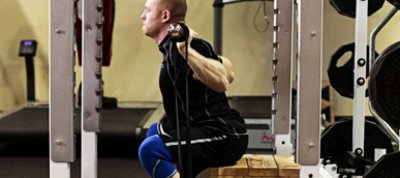Part 1 | Part 2
Assuming you've already read part one of my "Build Your Ultimate Home Gym" series, your bases are covered: Your rack and bench are set, you have a solid bar, and you probably have a pile of mismatched plates.
Championship programs have been built on the simplicity of such a setup. Heck, too much equipment may even distract you from your most productive work! With that said, there are a few more pieces of excellent iron a home trainee can add to his or her gym.
Bumper Plates
In my opinion, a gym that lacks bumper plates and a platform is only out to get your money and has no concern at all for your progress. Most gym chains won't let you use bumper plates correctly, even when they have them available.
True story: I was training a ranked competitive weightlifter on clean and jerks with bumpers on a platform, and management asked us to stop due to noise complaints. Yet another reason to break free from the big box gym!
Bumper plates are rubberized weights. They allow weights to be more safely dropped when doing Olympic-style lifts, and they reduce the amount of noise resulting from iron plates.

Bumper plates also are better for your bar and will protect your equipment and floor. These advantages make legitimate training facilities shell out the big bucks for them, as well as make them one of the most desired items for the home-trainer. Depending on your budget, you generally will have three options for bumper plates.
1. Competitive Weightlifting Discs
If you ever watch Olympic weightlifting, you've seen the colorful competition discs. These top-of-the-line bumpers feature a rubber body around a metal core. They're typically color coded, and all plates from 10-25 kg (or 25-55 pounds) are the same diameter. This way, when doing Olympic lifts, pulls, or deadlifts, the bar is always the proper distance from the floor. A proper bumper is about 17.7 inches in diameter, but heavier weights will be thicker.
These types of bumpers are highly regulated for the bar opening, and they're guaranteed to be within 10 grams of the labeled weight. This makes them expensive. However, these bumpers feature a higher-density rubber for less bounce, and are made to survive. Competition bumpers are the nicest option, but expect to pay $3-5 per pound, or more.
2. Economy Bumper Plates
Economy bumper plates still have the proper diameter, but are usually made of recycled tire rubber and don't have the tight weight tolerances that competitive discs have. Economy bumpers are usually black, and they're quite a bit thicker than the nicer sets, which can limit how much weight you can stack on the bar.
Most gyms and high schools use economy bumpers to save money. If abused, however, the metal collars may slip out. From a training standpoint, there is no serious difference that would result from using these bumpers over higher-quality sets. Expect to pay in the ballpark of $1-2.50 per pound.

3. Ghetto Bumpers!
I have to give my love to the poor man's ghetto gym. One pair of inexpensive 45-pound bumpers will probably cost you more than $150, but if you go ghetto, you can make your own for only a few bucks!
First, go to your local salvage yard and find a pair of identical wheels—in the ballpark of 16-18 inches (with the tires on, obviously). You may be able to get these for free. If not, you can probably purchase them for under $5. Not only is this size approximately the same as a normal bumper, but the weight is similar, too. I had 17-inch wheels that came in at an even 45 pounds.
You will quickly notice that the opening in the wheel is far too large for your bar. You will need a pair of 10-pound weights and the proper hardware. Drill a few holes into the 10-pound weights and bolt them in place to the wheel. Alternatively, if have the right shop setup, you can weld them in place. You now have wheels that should properly fit on your bar!
Quick Tip: If you don't want to buy a full set of bumpers, get as many 45s as you need and use your regular iron plates with bumpers on the end.
Bands
Bands are extremely versatile. Home gym or not, I tell everybody to buy some. Today's bands are not your Aunt Chloe's exercise doo-dahs; the bands I'm talking about can provide up to 200 pounds of dynamic resistance! Bands have been popularized by powerlifters and coaches, who use them to radically increase the strength levels of elite athletes. They are good for adding dynamic resistance to your bench or replacing an entire cable column; they are also extremely portable.

Normal bands are 41 inches long. They come in a variety of widths and resistances. For bench pressing, a pair of micro-mini bands will only cost you a few dollars each. They could be used for assisted pull-ups, squats, deadlifts, good mornings, triceps push-downs, and a hundred other things.
Some manufacturers make shorter, 12-inch bands specifically for the deadlift and bench press. These bands are easy to set up for those lifts, but they aren't as versatile as full-length bands.
Suspension Strap System
Suspension systems have recently become popular. Strap systems allow you to assume certain positions for bodyweight exercises like rows, presses, and more. Suspension training doesn't offer any resistance beyond your body weight, though it does make great stabilization training.
If you want to outfit your home gym with a suspension system, you don't have to shell out $100. Instead, visit your local hardware store! I found a pair of six-foot straps for less than $10 each, each rated to support more than a ton (2,000 pounds). They even had loops sewn in that work as handles.

With these straps suspended from my pull-up bar, I can perform virtually any movement I would do with the more expensive systems: dips, presses, rows, extensions, single-leg squats, and so on. I also use one of the straps for sled drags, making the cheap purchase even more useful.
For people with a power rack, the straps offer one final benefit. If your rack doesn't have one-inch hole spacing, add some high-strength chain to your straps to quickly convert them into an additional safety within your cage! The chain allows minute adjustments in your safeties, giving you a great array of training options. Certain movements I used to do off of pins, such as good mornings, are much better when done off the strap-chain setup.
Part 1 | Part 2

